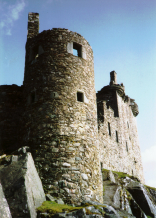Janet Horne 1722 or 1727
text from Scotland's Wicked Witches
Most accounts of witch trials in Scotland mention that the last execution apparently took place in Dornoch, Sutherland, although the whole episode is quite poorly recorded and the details are disputed: the date of the execution has been recorded as either 1722 or 1727 and even the names of the women are uncertain.
There is a small stone in Dornoch inscribed with the date 1722, said to mark the place where traditionally, a Janet Horne was executed for witchcraft.
It is claimed that she was accused of several practices including bizarrely turning her daughter into a pony so she could ride her to meetings with the Devil. Another account mentions that she was dragged through the streets of the town before being burned in a barrel of tar.
There are no surviving contemporary records, such as local kirk session or presbytery minutes, or applications for commissions, to provide any reliable first-hand primary evidence. Therefore a lot of what is claimed about this case is derived from much later accounts based on hearsay, second-hand accounts, and oral tradition.
One of the first documentary reports about Janet came from Captain Edmund Burt, who was employed to work on the construction of roads in the north of Scotland during the 1720s and 1730s – sometime after the Jacobite Rising of 1715.
He was somewhat surprised to note that in the Highlands of Scotland belief about witches was still quite widespread. His account has two women from Loth in Sutherland (about twenty miles from Dornoch), an unnamed mother and daughter, who were tried for witchcraft and condemned to death. The younger woman escaped, but the older woman was burned in a ‘pitch barrel at Dornoch’ in 1727.
Burt’s account was published in 1754, well after the supposed event, and it is not clear if Burt witnessed it or if he simply relied on hearsay evidence.
The 1727 date appears to be supported by an account by James Fraser of Alness who mentioned an anonymous case from Loth in 1727 and Thomas Pennant, who toured Scotland in 1769, recorded that he had heard an account of what were said to be the last executions in 1727. A later version in Sinclair’s Statistical Account of the 1790s stated somewhat vaguely that between 1717 and 1730 the last ‘unhappy woman’ was executed for witchcraft at Dornoch.
In 1819 another version by Charles Kirkpatrick Sharpe dated the execution to 1722, and provided further details about the case including a description of the mother riding her daughter, who was transformed into a pony and shod by the Devil.
It was this Devilish procedure that made the daughter lame thereafter. It is in Sharpe’s account that the description of the supposedly elderly Janet warming herself by the fire before being burnt first appeared.
This later account was given credibility by Sir Walter Scott, who was a supporter of the much maligned Countess of Sutherland. The countess told Scott about the execution, as it related to her family’s estates, and her account mentioned that the daughter had burnt her hands when she was a child and had suffered from scarring which caused her hands to look twisted and contracted.
According to the countess, it was popularly believed that the mother had caused the accident by witchcraft. Although to confuse the matter further – and to add weight to a completely natural physical abnormality – it was also claimed by the countess that the grandson of the daughter still lived locally (in the early nineteenth century) and that all subsequent generations of the family had the same sort of anomaly.
It is not clear when the woman was given the name Janet or Jenny Horne; all versions until the twentieth century made no reference to her name. It may well be that the name is fictitious as Jenny Horne is the north-east term for a witch.
Although the subject of a play by Rona Munro, The Last Witch, there is so much that is either unknown or inaccurate that it is almost impossible to even claim that this was the last execution in Scotland.
Even if she was apocryphal, however, Janet or Jenny can still be memorialised as a representation of the many other, named, women and men who were executed in earlier years.
The event is said to be commemorated in more than just literature. For the ghost of Janet Horne is reputed seen sometimes at the stone, being consumed by spectral flames in a barrel of pitch.
© Martin Coventry 2017








